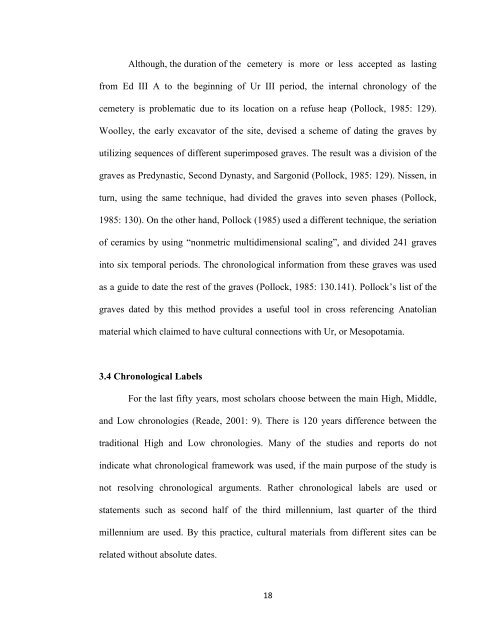EARLY BRONZE AGE DAGGERS IN CENTRAL ... - Bilkent University
EARLY BRONZE AGE DAGGERS IN CENTRAL ... - Bilkent University
EARLY BRONZE AGE DAGGERS IN CENTRAL ... - Bilkent University
You also want an ePaper? Increase the reach of your titles
YUMPU automatically turns print PDFs into web optimized ePapers that Google loves.
Although, the duration of the cemetery is more or less accepted as lasting<br />
from Ed III A to the beginning of Ur III period, the internal chronology of the<br />
cemetery is problematic due to its location on a refuse heap (Pollock, 1985: 129).<br />
Woolley, the early excavator of the site, devised a scheme of dating the graves by<br />
utilizing sequences of different superimposed graves. The result was a division of the<br />
graves as Predynastic, Second Dynasty, and Sargonid (Pollock, 1985: 129). Nissen, in<br />
turn, using the same technique, had divided the graves into seven phases (Pollock,<br />
1985: 130). On the other hand, Pollock (1985) used a different technique, the seriation<br />
of ceramics by using “nonmetric multidimensional scaling”, and divided 241 graves<br />
into six temporal periods. The chronological information from these graves was used<br />
as a guide to date the rest of the graves (Pollock, 1985: 130.141). Pollock’s list of the<br />
graves dated by this method provides a useful tool in cross referencing Anatolian<br />
material which claimed to have cultural connections with Ur, or Mesopotamia.<br />
3.4 Chronological Labels<br />
For the last fifty years, most scholars choose between the main High, Middle,<br />
and Low chronologies (Reade, 2001: 9). There is 120 years difference between the<br />
traditional High and Low chronologies. Many of the studies and reports do not<br />
indicate what chronological framework was used, if the main purpose of the study is<br />
not resolving chronological arguments. Rather chronological labels are used or<br />
statements such as second half of the third millennium, last quarter of the third<br />
millennium are used. By this practice, cultural materials from different sites can be<br />
related without absolute dates.<br />
18
















